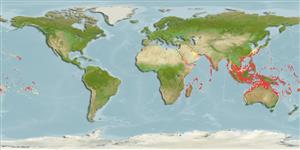Common names from other countries
>
Syngnathiformes (Pipefishes and seahorses) >
Syngnathidae (Pipefishes and seahorses) > Syngnathinae
Etymology: Hippocampus: Greek, ippos = horse + Greek,kampe = curvature (Ref. 45335).
More on author: Kaup.
Environment: milieu / climate zone / depth range / distribution range
Ecologia
marino associati a barriera corallina; non migratori; distribuzione batimetrica 0 - 82 m (Ref. 37816), usually 15 - 40 m (Ref. 90102). Tropical; 35°N - 35°S, 22°E - 132°W
Indo-Pacific: South Africa to French Polynesia; north to Japan, south to Australia. Not in the Red Sea.
Length at first maturity / Size / Peso / Age
Maturity: Lm 7.9 range ? - ? cm
Max length : 17.0 cm TL maschio/sesso non determinato; (Ref. 11441)
Short description
Chiavi di identificazione | Morfologia | Morfometria
Spine dorsali (totale) : 0; Raggi dorsali molli (totale) : 15 - 18; Spine anali: 0; Raggi anali molli: 4.
A rare inhabitant of shallow sheltered reefs, found among clumps of algae or in seagrass beds. Large adult pelagic and probably associated with drifting debris. Associated with sponges and sea-squirts (Ref. 30915, 58302). Ovoviviparous (Ref. 205). Feeds on zooplanktons and small crustaceans (Ref. 89972). The male carries the eggs in a brood pouch which is found under the tail (Ref. 205). Use in traditional Chinese medicine is increasing with the rise in patent medicines (Ref. 30915). Not common in the aquarium trade (Ref. 30915). Minimum depth reported taken from Ref. 128812.
Life cycle and mating behavior
Maturities | Riproduzione | Spawnings | Egg(s) | Fecundities | Larve
Monogamous mating is observed as both obligate and genetic (Ref. 52884). Male carries the eggs in a brood pouch (Ref. 205).
Lourie, S.A., R.A. Pollom and S.J. Foster, 2016. A global revision of the seahorses Hippocampus Rafinesque 1810 (Actinopterygii: Syngnathiformes): taxonomy and biogeography with recommendations for further research. Zootaxa 4146(1):1-66. (Ref. 115213)
IUCN Red List Status (Ref. 130435)
Threat to humans
Harmless
Human uses
Pesca: elevato interesse commerciale; Acquario: Commerciale
Strumenti
Special reports
Download XML
Fonti Internet
Estimates based on models
Preferred temperature (Ref.
115969): 24.4 - 29, mean 28.1 (based on 1240 cells).
Phylogenetic diversity index (Ref.
82804): PD
50 = 0.5000 [Uniqueness, from 0.5 = low to 2.0 = high].
Bayesian length-weight: a=0.00447 (0.00177 - 0.01127), b=3.00 (2.78 - 3.22), in cm Total Length, based on LWR estimates for this (Sub)family-body shape (Ref.
93245).
Trophic level (Ref.
69278): 3.5 ±0.53 se; based on food items.
Resilienza (Ref.
120179): Alto, tempo minimo di raddoppiamento della popolazione meno di 15 mesi (Preliminary K or Fecundity.).
Fishing Vulnerability (Ref.
59153): Low vulnerability (10 of 100).
